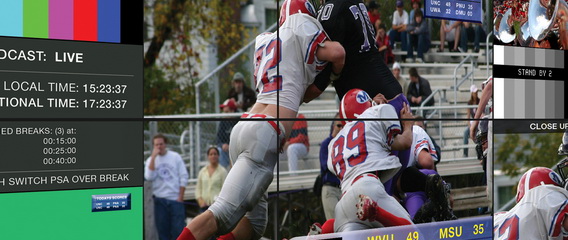We’ve all been there: It’s Sunday and that means football. But if you want to watch the NFL Sunday Ticket and the NHL game, you’ll inevitably end up toggling back and forth between channels and missing out on some of the action. Throw NBA and fantasy football into the mix and suddenly you are trying to catch multiple games, leaving you with carpel tunnel syndrome from playing remote jockey and an overall sense of dissatisfaction. Sure, you could record a game or two on your DVR to watch later, but then you run the risk of glimpsing ‘the spoiler’ via your Twitter feed.
The multi-screen solution
The best solution for these multi-game woes is a multi-screen media wall that allows you to enjoy as many games as you have displays. While some cable and satellite TV channels do offer multiple views of various games onscreen at once, they are not very elegant solutions. For one, games are shrunken so that several will fit on one screen simultaneously.
Multi-screen video walls are the answer for any discerning sports fan, allowing you to enjoy each game in high-definition resolution on a large screen. Some multi-screen walls consist of one larger display in the middle flanked by two or four additional screens, but it’s really up to you how big the displays will be, how they will be arranged or how many to include. While multi-screen setups are nothing new, it has becoming far easier to achieve, afford and control them.
Complex tech made easy
Because multi-screen video walls can be complex due to the sheer amount of screens and sources involved, you’ll need the help of a skilled integrator who has experience designing and installing this type of system. Next, you want to consider how many sources to include. While you can send video from one source to multiple displays, if you want each screen in your video wall to have the capability of displaying different channels, you’ll need as many cable or satellite boxes as you have displays. For most other sources—like a Blu-ray player—one unit should suffice. After all, most people tend to watch only one movie at a given time.
We can hook you up with a video processor/switcher that acts as the middleman between your sources and displays, shuttling video here and there and making sure everything gets where you want it to go with optimal quality.
When choosing displays for your video wall—whether projections screen or flat-panel displays—consider models that have thin or nonexistent bezels for a more aesthetically pleasing look. A video wall looks more streamlined when black borders between displays are minimized—especially if you plan on mounting them close together.
Controlling your video wall
A control touch screen or tablet running a control app are the easiest ways to operate a multi-screen video wall, as opposed to a hard-button remote control. Touch screens make it easier to simply select the graphic representation of a TV and choose content for that screen or choose which screen you want to hear through the audio system. We will make controlling this sophisticated video technology as simple as a finger-press.
OK, how much?
While a high-end multi-screen setup can be expensive due to the sheer amount of gear necessary they are becoming more and more affordable. Advances in video-distribution, switching and processing technology, decreased prices for flat-panel TVs and the various intuitive control systems on the market make it easier than ever to start enjoying all your sporting events as they happen. Give us a shout and we’ll make it so that you never have to miss another touchdown!

